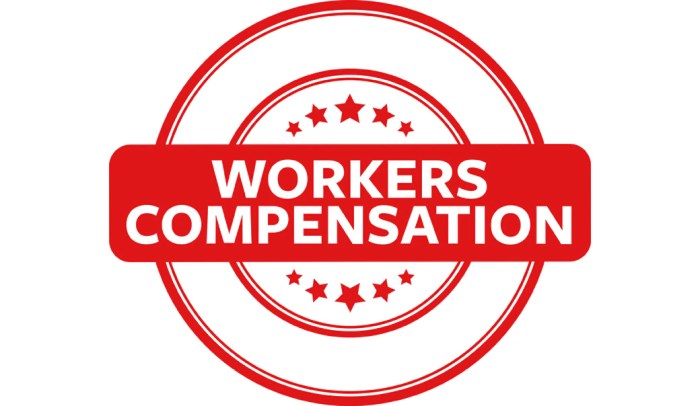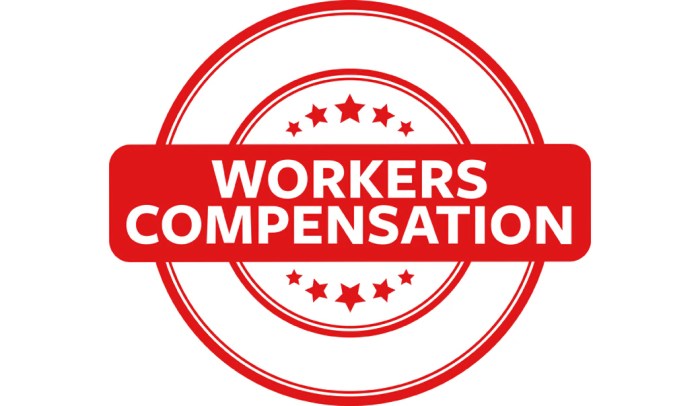Workman’s comp insurance is a crucial safety net for both employees and employers. It provides financial protection for workers who experience injuries or illnesses on the job, while also shielding businesses from potentially devastating lawsuits. This system, rooted in the principles of fairness and responsibility, has evolved significantly over time, adapting to changing workplace dynamics and legal landscapes.
Understanding the intricacies of workman’s comp insurance is essential for anyone involved in the workforce. From the types of coverage and benefits available to the process of filing a claim and the legal considerations involved, navigating this system requires a clear understanding of its various components.
This guide aims to provide a comprehensive overview of workman’s comp insurance, empowering readers to make informed decisions about their rights and responsibilities.
What is Workman’s Comp Insurance?
Workman’s compensation insurance, also known as workers’ compensation insurance, is a type of insurance that provides financial protection to employees who are injured or become ill as a result of their work. This insurance covers medical expenses, lost wages, and other benefits to help employees recover and return to work.
Workman’s comp insurance is a crucial aspect of workplace safety and employee well-being. It aims to ensure that employees receive necessary medical care and financial support during their recovery period, while also protecting employers from potential lawsuits and financial burdens arising from work-related injuries or illnesses.
History of Workman’s Comp Insurance
The concept of workman’s compensation insurance originated in the late 19th century, driven by the growing industrialization and the increasing number of workplace accidents. Early forms of worker protection were limited, often relying on common law doctrines like negligence, which placed a significant burden on injured workers to prove their employer’s fault.The first workman’s compensation laws were enacted in Germany in 1884.
The United States followed suit in the early 20th century, with the first state law being passed in Wisconsin in 1911. These early laws established a system of no-fault compensation, meaning that injured workers could receive benefits regardless of whether their employer was at fault.
Types of Workman’s Comp Insurance Policies
Workman’s comp insurance policies can vary depending on the specific needs of the employer and the state in which they operate. Here are some common types of policies:
- Standard Policy:This is the most common type of policy, providing basic coverage for medical expenses, lost wages, and death benefits.
- Excess Policy:An excess policy provides additional coverage beyond the limits of a standard policy. It can be used to cover high-cost medical expenses or lost wages for high-earning employees.
- Umbrella Policy:An umbrella policy provides extra liability coverage for employers, protecting them from claims exceeding the limits of their underlying workman’s comp policy.
- Retrospective Rating Policy:This type of policy allows employers to pay premiums based on their actual claims experience over a specific period. This can be advantageous for employers with a good safety record and low claims history.
Who Needs Workman’s Comp Insurance?
Workman’s compensation insurance is mandatory for certain employers, and it’s essential to understand who falls under this requirement. This ensures that employees have access to medical care and lost wages in the event of a work-related injury or illness.
Employers Required to Have Workman’s Comp Insurance
Employers are generally required to carry workman’s comp insurance if they have employees. The specific rules vary by state, but most states require coverage for employers with at least one employee. There are some exceptions, such as small businesses with only family members as employees, but it’s best to consult with a qualified insurance agent or attorney to determine your specific requirements.
Independent Contractors and Workman’s Comp Insurance
While independent contractors are generally not considered employees, there are situations where they may need workman’s comp insurance. This typically occurs when the contractor is performing work that is considered inherently dangerous or risky. For example, if a contractor is working on a construction project that involves heights or heavy machinery, they may be required to have workman’s comp insurance.
Consequences of Not Having Workman’s Comp Insurance
Failing to carry workman’s comp insurance when required can have serious consequences. If an employee is injured on the job and the employer does not have insurance, the employer could be held personally liable for the employee’s medical expenses, lost wages, and other damages.
This could result in significant financial losses, legal fees, and even criminal penalties. In addition, employers without workman’s comp insurance may face difficulty attracting and retaining employees, as workers may be hesitant to take on risky jobs without the protection of insurance.
Coverage and Benefits of Workman’s Comp Insurance

Workman’s compensation insurance is a crucial safety net for employees who experience work-related injuries or illnesses. This type of insurance provides financial protection and medical benefits to help them recover and return to work. Understanding the coverage and benefits offered by workman’s comp insurance is essential for both employers and employees.
Types of Injuries and Illnesses Covered
Workman’s comp insurance typically covers a wide range of injuries and illnesses that occur during the course of employment. These can include:
- Accidents:This includes injuries sustained from slips, trips, falls, machinery malfunctions, and other unexpected events.
- Repetitive Strain Injuries (RSIs):These injuries result from repetitive motions, such as typing, lifting, or using tools, leading to conditions like carpal tunnel syndrome or tendonitis.
- Occupational Diseases:These are illnesses caused by exposure to hazardous substances or conditions in the workplace, such as asbestos exposure, chemical burns, or respiratory problems.
- Mental Health Conditions:In some cases, workman’s comp insurance may cover mental health conditions arising from workplace stress, harassment, or traumatic events.
Benefits Provided by Workman’s Comp Insurance
Workman’s comp insurance provides a variety of benefits to injured or ill employees, including:
- Medical Expenses:This covers all reasonable and necessary medical costs related to the work-related injury or illness, including doctor visits, hospital stays, surgeries, medication, and physical therapy.
- Lost Wages:Workman’s comp insurance provides temporary disability benefits to replace a portion of lost wages while the employee is unable to work. These benefits are typically calculated based on the employee’s average weekly wage.
- Permanent Disability Payments:If the injury or illness results in a permanent disability, workman’s comp insurance may provide ongoing payments to compensate for the loss of earning capacity. These payments can be structured as a lump sum or regular installments.
- Vocational Rehabilitation:In some cases, workman’s comp insurance may cover the costs of vocational rehabilitation services, such as job training or retraining, to help employees find new employment if their previous job is no longer suitable due to their injury or illness.
Examples of Situations Covered by Workman’s Comp
Here are some examples of specific situations where workman’s comp insurance would cover expenses:
- A construction worker falls from a ladder and breaks his leg:Workman’s comp would cover the medical expenses for his treatment, as well as lost wages while he is unable to work.
- An office worker develops carpal tunnel syndrome due to repetitive typing:Workman’s comp would cover the medical expenses for treatment, as well as lost wages while she is unable to work.
- A factory worker develops lung cancer due to exposure to asbestos:Workman’s comp would cover the medical expenses for treatment, as well as lost wages and potential permanent disability payments.
Filing a Workman’s Comp Claim
Filing a workman’s comp claim is a crucial step in receiving compensation for work-related injuries or illnesses. The process involves notifying your employer and the insurance company, providing documentation, and undergoing medical evaluations. Understanding the steps involved and the necessary documentation will help ensure a smooth and successful claim process.
Documentation Required for a Workman’s Comp Claim
Documentation is essential for supporting your workman’s comp claim. It provides evidence of your injury or illness, its connection to your work, and the extent of your medical treatment.
- Incident Report:This report details the circumstances surrounding your injury or illness, including the date, time, location, and nature of the incident. It should be completed as soon as possible after the incident occurs.
- Medical Records:Medical records from all healthcare providers involved in your treatment are crucial. These records document your diagnosis, treatment plan, and prognosis. They should include doctor’s notes, test results, and prescriptions.
- Wage and Employment Information:This information includes your pay stubs, employment contract, and job description. It helps determine your average weekly wage, which is used to calculate your benefits.
- Witness Statements:If other individuals witnessed your injury or illness, their statements can provide valuable supporting evidence.
Role of Employers and Insurance Companies in the Claims Process
Both your employer and the insurance company play vital roles in the workman’s comp claims process.
- Employer’s Responsibilities:Your employer is responsible for reporting your injury or illness to the insurance company and providing you with the necessary forms to file a claim. They should also maintain a safe work environment to prevent workplace injuries.
- Insurance Company’s Responsibilities:The insurance company is responsible for reviewing your claim, determining eligibility for benefits, and providing payment for medical expenses and lost wages. They may also assign a case manager to assist you with the claims process.
Cost of Workman’s Comp Insurance
The cost of workman’s comp insurance, often referred to as workers’ compensation insurance, is a significant expense for businesses. Understanding the factors that influence this cost and exploring strategies to reduce it is crucial for any employer.
Factors Influencing the Cost of Workman’s Comp Insurance
The cost of workman’s comp insurance is determined by several factors, primarily related to the risk of workplace injuries and illnesses.
- Industry: Some industries are inherently riskier than others. For instance, construction, manufacturing, and mining typically have higher injury rates, leading to higher insurance premiums.
- Size of the Company: Larger companies generally have more employees, increasing the potential for workplace injuries. Consequently, they may face higher insurance premiums.
- Safety Record: Businesses with a strong safety record and a low frequency of workplace injuries are typically rewarded with lower insurance premiums. Conversely, companies with a history of frequent claims or serious incidents may face higher premiums.
- State Regulations: Each state has its own set of regulations governing workman’s comp insurance. These regulations can influence the cost of insurance, including the benefits provided and the premium rates charged.
- Employee Demographics: Factors like the age, gender, and occupation of employees can influence premium rates. For example, industries with a higher proportion of older or physically demanding jobs may have higher premiums.
Strategies for Reducing the Cost of Workman’s Comp Insurance
There are several strategies that businesses can implement to reduce their workman’s comp insurance costs:
- Improve Safety Practices: Implementing a comprehensive safety program that includes regular training, safety audits, and hazard mitigation measures can significantly reduce the risk of workplace injuries, leading to lower premiums.
- Invest in Safety Equipment: Providing employees with appropriate safety equipment, such as personal protective gear, can help prevent injuries and reduce the severity of incidents.
- Develop a Strong Safety Culture: Creating a culture of safety where employees feel empowered to report hazards and participate in safety initiatives can significantly reduce the likelihood of accidents.
- Manage Claims Effectively: Timely and efficient claim management can help minimize the cost of claims and avoid unnecessary delays and disputes.
- Shop Around for Insurance: Comparing quotes from different insurance providers can help businesses secure the best rates and coverage options. It’s essential to consider the insurer’s financial stability, claims handling processes, and customer service.
Workman’s Comp Insurance and Legal Considerations
Workman’s compensation insurance is a complex legal system with its own set of rules and regulations. It’s important to understand the legal framework surrounding this type of insurance to navigate potential claims and ensure compliance.
Legal Framework of Workman’s Comp Insurance
The legal framework of workman’s compensation insurance is governed by state laws. Each state has its own unique set of rules and regulations regarding eligibility, benefits, and procedures for filing claims. The purpose of these laws is to provide a system for compensating employees who are injured or become ill as a result of their work, without requiring them to sue their employers.
Rights and Responsibilities of Employers and Employees
Employers’ Rights and Responsibilities
Employers have a legal obligation to provide workman’s compensation insurance to their employees. This includes:
- Paying premiums for the insurance policy.
- Maintaining a safe work environment.
- Providing prompt and accurate information about the insurance policy to employees.
- Cooperating with the insurance company during the claims process.
Employees’ Rights and Responsibilities
Employees have the right to receive benefits if they are injured or become ill as a result of their work. This includes:
- Medical expenses related to the injury or illness.
- Lost wages while they are unable to work.
- Permanent disability benefits if they are unable to return to their previous job.
Employees also have the responsibility to:
- Report the injury or illness to their employer promptly.
- Cooperate with the insurance company during the claims process.
- Follow their doctor’s orders.
Examples of Legal Cases
Case 1: Smith v. Acme Manufacturing
In this case, an employee, Smith, was injured while operating a machine at his workplace. Smith filed a claim for workman’s compensation benefits, but his employer, Acme Manufacturing, denied the claim, arguing that the injury was not work-related. The court ruled in favor of Smith, finding that the injury was indeed work-related and that Acme Manufacturing was liable for the benefits.
Case 2: Jones v. XYZ Construction
Jones, a construction worker, was injured while working on a building project. Jones filed a claim for workman’s compensation benefits, but the insurance company denied the claim, arguing that Jones had not reported the injury promptly. The court ruled in favor of the insurance company, finding that Jones had failed to meet the reporting requirements of the state’s workman’s compensation law.
Case 3: Brown v. ABC Company
Brown, an office worker, developed carpal tunnel syndrome as a result of her work on a computer. Brown filed a claim for workman’s compensation benefits, but ABC Company argued that the condition was not work-related. The court ruled in favor of Brown, finding that her carpal tunnel syndrome was a work-related injury and that ABC Company was liable for the benefits.
Closure: Workman’s Comp Insurance
Workman’s comp insurance stands as a vital pillar of workplace safety and financial security. It fosters a culture of responsibility by ensuring that workers are protected in the event of job-related injuries or illnesses. By understanding the nuances of this system, both employers and employees can navigate its complexities with confidence, ensuring that their rights and obligations are met.
From navigating the claims process to understanding the legal framework surrounding workman’s comp, knowledge is power in this critical area of workplace safety.
Clarifying Questions
What happens if my employer doesn’t have workman’s comp insurance?
If your employer is required to have workman’s comp insurance and does not, they could face serious penalties, including fines and even jail time. You may also be able to pursue a claim directly against your employer for your injuries or illness.
How long do I have to file a workman’s comp claim?
The time limit for filing a workman’s comp claim varies by state. It’s important to check your state’s specific laws to determine the deadline. Generally, you have a limited period of time, usually a few years, to file a claim.
Can I choose my own doctor for treatment under workman’s comp?
In some states, you have the right to choose your own doctor for treatment under workman’s comp. However, in other states, your employer or their insurance company may designate a specific doctor or network of doctors. Check your state’s laws to understand your options.




